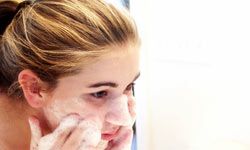It's the night before the big event, and you're completely prepared. The perfect outfit? Check. Great haircut? Check. Beautiful, healthy, glowing skin from taking such good care of it day after day? Check. Wait a minute, is that a zit? Are you kidding me?
We've all had them -- those bright red beacons of embarrassment that, while small, can sometimes feel like a giant neon light blinking "Look at me! Look at me!" over and over again. Sometimes it even seems like pimples have a mind of their own, like they're lying in wait and calculating the worst time to burst onto the scene and spoil that big job interview, first date or keynote speech.
Advertisement
For some of us, pimples are a rare occurrence. But for those of us who aren't so lucky, it can seem like a constant fight to keep the battleground of our faces clear from dermatological disaster. So we think it's time you began winning the war -- which is why we're arming you with our top five ways to clean acne-prone skin.
